|
|
The Spencer Family Web |
||||||||||||||||||||||||||||||||||
|
The Beach 40 DSB Transceiver |
||||||||||||||||||||||||||||||||||
|
Perhaps it would be more accurate to say 'yet another Beach 40' as a number of people have built this transceiver. I first heard about the Beach40 in a 'Solder smoke' recording and then found it on 'You Tube' where it has been presented by the developer VK3YE. Watching the 'You Tube' video's reminded me that like so many others these days I buy my equipment and don't build as much as I used to and I certainly haven't built anything for some time. That spurred me on to have a go at the Beach 40 which is a simple DSB (Double Sideband) transceiver for the 40 metre band and with an output power of about 2 watts, so very much QRP and the receiver is a direct conversion type. What intrigued me was the fact that I could build a complete transmitter and receiver using just 8 transistors or 6 transistors and one audio amplifier chip. The other fact that interested me was that it used a ceramic resonator in the oscillator rather than the more usual Xtal or VFO design. |
||||||||||||||||||||||||||||||||||
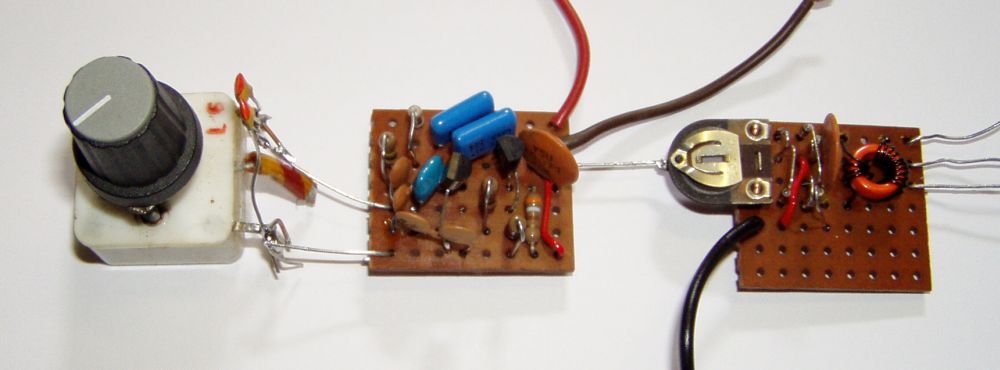 |
||||||||||||||||||||||||||||||||||
|
I decided to use perforated board for the build and to build the circuit using a number of seperate modules. In fact the first module is the Oscillator and buffer, the next the balanced modulator/Demodulator, then the microphone preamplifier, the receive audio amplifier, the transmit amplifier stages, the pi filter network and finally the 2W 40 metre PA. I started with the oscillator which you can see to the left in the photo above and it is built on a piece of perf board about 3cm x 3cm. The transistor to the left is the oscillator and that on the right is the buffer. As I mentioned I used a ceramic resonator to control the resonant frequency. Using a Xtal would only have allowed the frequency to be pulled by about 20Khz or so and if I had built a free running VFO then it would have covered the whole of the 40 Metre band but would have been much less stable than with a Xtal and so not so suitable for SSB or DSB operation. The ceramic resonator is a very good compromise allowing a tuning range of around 150Khz but with almost Xtal stability. The resonator I bought was for 7.2Mhz though with only a few pf of capacitance added it resonated at nearer 7.3Mhz. So across the tuning capacitor you can see around 22pf of fixed capacitance to bring it down to the band edge of 7.2Mhz and the variable capacitor (about 150pf) tunes it down to 7.050Mhz covering the complete phone section of the band. Once built it worked first time and without a load gives an output of about 6 Volts Peak to Peak and a very clean sine wave. The next module shown on the right in the photo is the balanced modulator which uses a network of 4 diodes and a small toroid output transformer. This allows pretty good carrier suppression though I haven't yet measured exactly how good it is. When mixed with the audio from the microphone preamplifier this modules DSB output is fed into the 3 transistor transmit amplifier chain. On receive this module becomes the demodulator and feeds the recovered audio into the audio amplifier stages. |
||||||||||||||||||||||||||||||||||
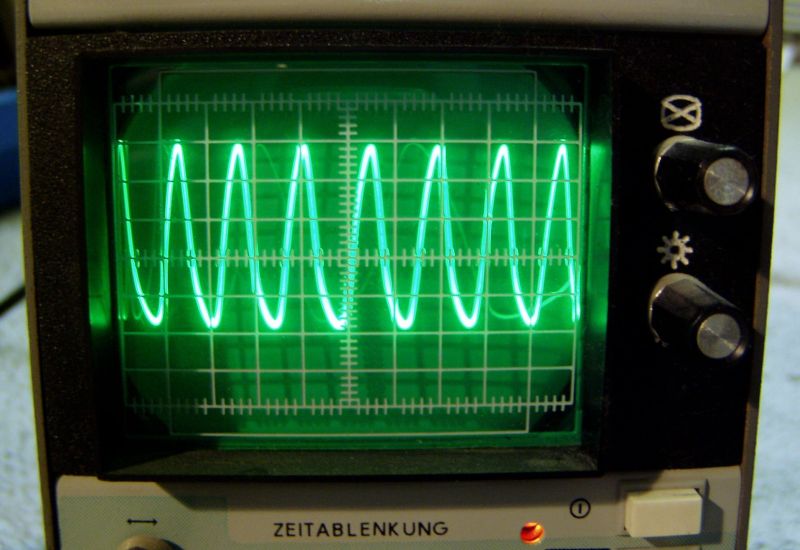 |
||||||||||||||||||||||||||||||||||
|
7.1Mh Output from the oscillator buffer under load |
||||||||||||||||||||||||||||||||||
|
The third board is the microphone preamplifier which amplifies the output from a small electret insert which you can see in the photograph and this is then coupled into the balanced modulator and provides a DSB output of about 0.8 volts Peak to Peak from the right hand side of the balanced modulator. This module also worked just as it should and. I was amazed that all three of the modules had worked first time, my luck couldn't last and it didn't..... |
||||||||||||||||||||||||||||||||||
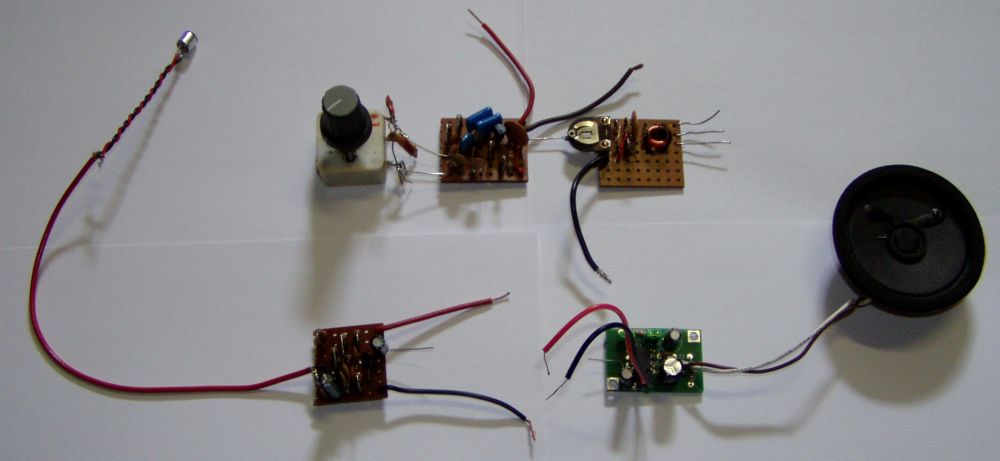 |
||||||||||||||||||||||||||||||||||
|
I then went on to build the first transmit amplifier stage which seems to attenuate the signal rather than amplifying it, so more work needed there and then two different audio amplifiers, one using 2 transistors and the commercial LM386 kit shown on the green board, both of which refuse to remain stable when I have enough gain and immediately go into oscillation. So the part I thought was going to be easy, building the amplifiers is turning out to be a pain and the part I thought would be more difficult, the oscillator and mixer worked first time, but that's life. |
||||||||||||||||||||||||||||||||||
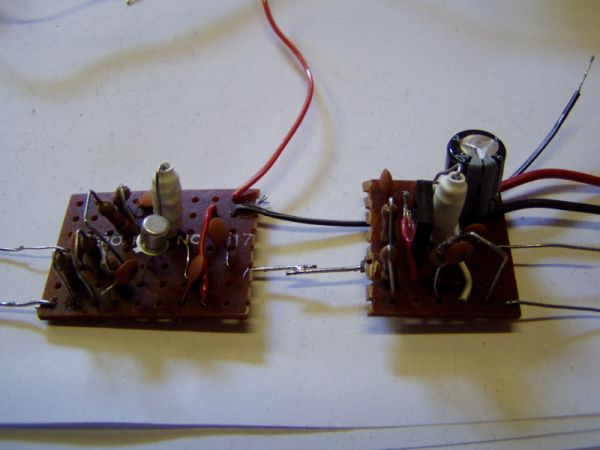 |
||||||||||||||||||||||||||||||||||
|
Here you can see the first two RF amplifier stages for the transmitter, now working after installing the wire link I forgot. The first stage on the left is a 2N2222 feeding into the BD139 stage which produces about 250mW output for the PA. |
||||||||||||||||||||||||||||||||||
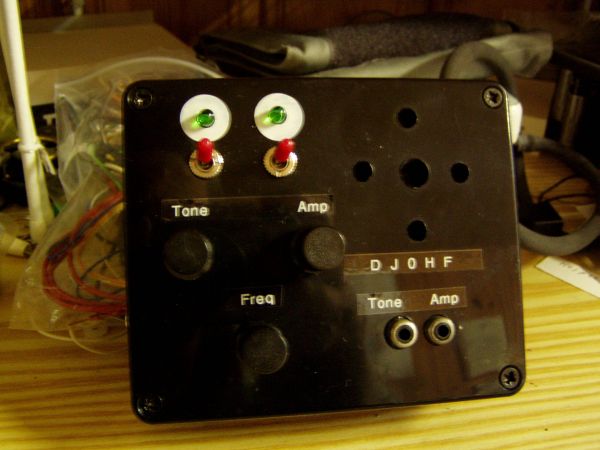 |
||||||||||||||||||||||||||||||||||
|
For testing both the transmitter and receiver I have constructed a little variable frequency audio tone generator and a general purpose LM380 AF Amplifier. Both are built into this little plastic case with an internal 9V block battery or it can accept an external 9 to 12 V supply. The socket for which you canjust see on the left hand edge. |
||||||||||||||||||||||||||||||||||
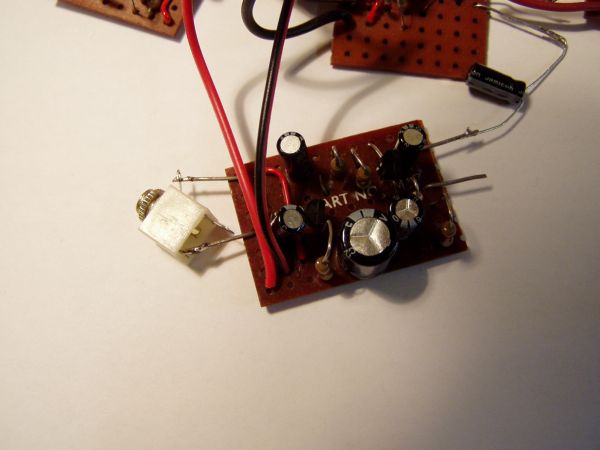 |
||||||||||||||||||||||||||||||||||
|
This is the two transistor audio amplifier which now works really well with a very sensitive crytal earphone or it can be fed into the LM380 amp shown above and gives good loudspeaker output with S8 to S9 signals. Though weaker signals are better listened too on headphones. With only 2 Watts from the transmitter I think the stations I'm likely to be working are going to be S9 or S9+.. It was amazing to hear the stable SSB reception with just 4 transistors for the complete receiver. |
||||||||||||||||||||||||||||||||||
|
At the moment the Beach40 is still not built into a cabinet and the receiver section is just 3 little boards as shown above. But I have made a short mp3 of reception on 40 metres. It was about 5 minutes of tuning around on 40 and there is no RF or AF filtering at all (not even the pi filter) so the FD4 windom antenna is connected straight into the demodulator board and the output from the 2 transistor AF amplifier fed into my black box amplifier shown above with a microphone laying next to the speaker. The tuning capacitor is as shown above and so 180 degrees is 150Khz with no slow motion drive so tuning in SSB is not easy but if you would like to hear it in action complete with some AM broadcast breakthrough, here it is..... |
||||||||||||||||||||||||||||||||||
|
Beach 40 MP3 |
||||||||||||||||||||||||||||||||||
|
[Home] [Ian and Julie] [Family News] [Hobbies] [Ham Bands] [Colin's Gallery] [Family Funnies] [Bits'n Pieces] [RAIBC] [Downloads] [Impressum] |














